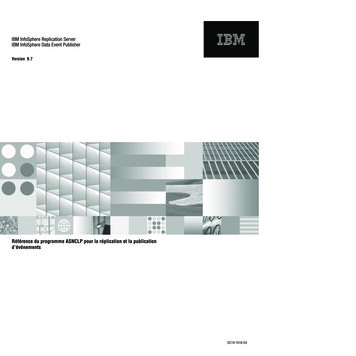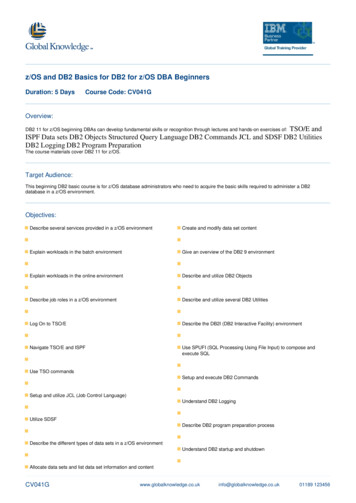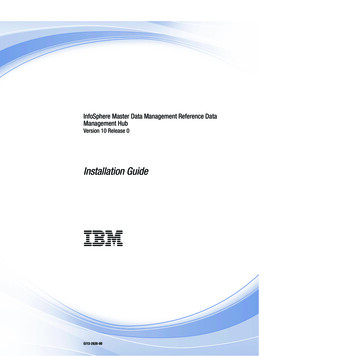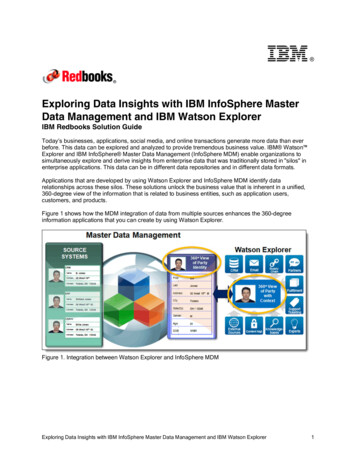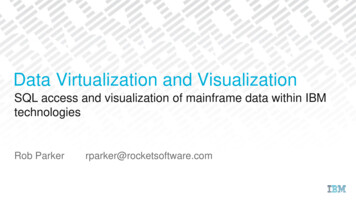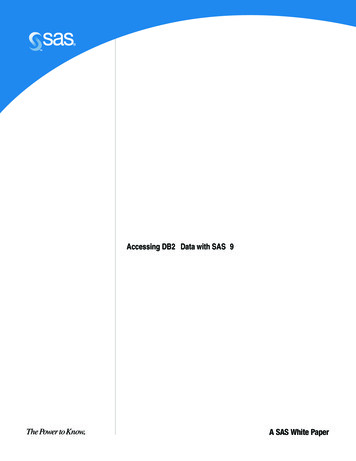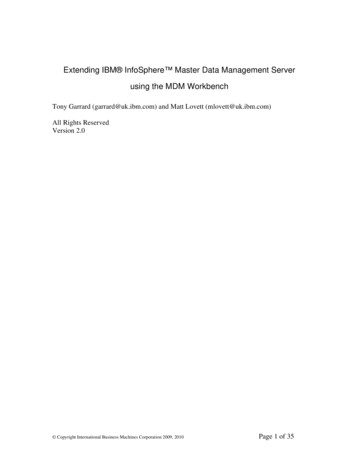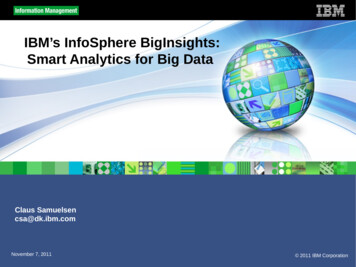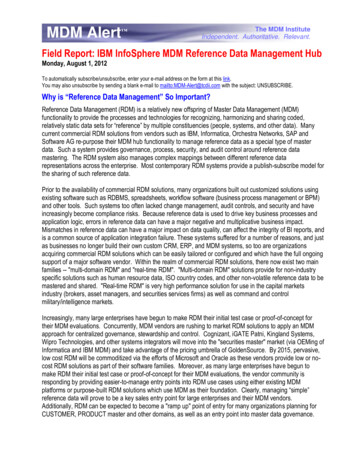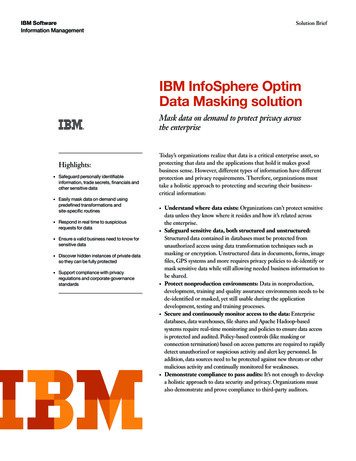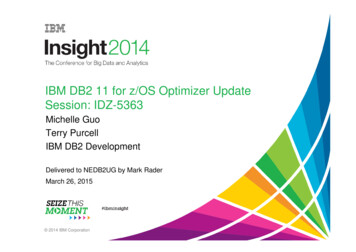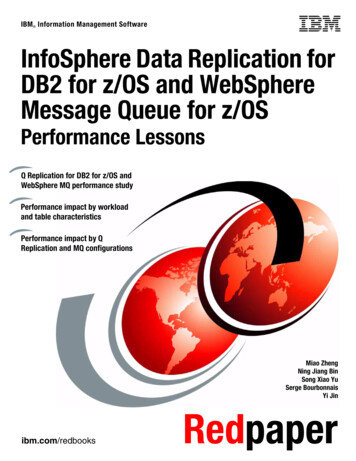
Transcription
IBM Information Management SoftwareFront coverInfoSphere Data Replication forDB2 for z/OS and WebSphereMessage Queue for z/OSPerformance LessonsQ Replication for DB2 for z/OS andWebSphere MQ performance studyPerformance impact by workloadand table characteristicsPerformance impact by QReplication and MQ configurationsMiao ZhengNing Jiang BinSong Xiao YuSerge BourbonnaisYi Jinibm.com/redbooksRedpaper
International Technical Support OrganizationInfoSphere Data Replication for DB2 for z/OS andWebSphere Message Queue for z/OSPerformance LessonsDecember 2012REDP-4947-00
Note: Before using this information and the product it supports, read the information in “Notices” on page v.First Edition (December 2012)This edition Version 10, Release 1 of InfoSphere Data Replication for DB2 for z/OS (program number5655-DRP) and Version 7, Release 0, Modification 1 of WebSphere MQ for z/OS (program number5655-R36). Copyright International Business Machines Corporation 2012. All rights reserved.Note to U.S. Government Users Restricted Rights -- Use, duplication or disclosure restricted by GSA ADP ScheduleContract with IBM Corp.
ContentsNotices . . . . . . . . . . . . . . . . . . . . . . . . . . . . . . . . . . . . . . . . . . . . . . . . . . . . . . . . . . . . . . . . . .vTrademarks . . . . . . . . . . . . . . . . . . . . . . . . . . . . . . . . . . . . . . . . . . . . . . . . . . . . . . . . . . . . . . viPreface . . . . . . . . . . . . . . . . . . . . . . . . . . . . . . . . . . . . . . . . . . . . . . . . . . . . . . . . . . . . . . . . . viiThe team who wrote this paper . . . . . . . . . . . . . . . . . . . . . . . . . . . . . . . . . . . . . . . . . . . . . . . viiNow you can become a published author, too! . . . . . . . . . . . . . . . . . . . . . . . . . . . . . . . . . . viiiComments welcome. . . . . . . . . . . . . . . . . . . . . . . . . . . . . . . . . . . . . . . . . . . . . . . . . . . . . . . viiiStay connected to IBM Redbooks . . . . . . . . . . . . . . . . . . . . . . . . . . . . . . . . . . . . . . . . . . . . . ixChapter 1. Introduction. . . . . . . . . . . . . . . . . . . . . . . . . . . . . . . . . . . . . . . . . . . . . . . . . . . . 11.1 Background information . . . . . . . . . . . . . . . . . . . . . . . . . . . . . . . . . . . . . . . . . . . . . . . . . 21.2 Observations and conclusions . . . . . . . . . . . . . . . . . . . . . . . . . . . . . . . . . . . . . . . . . . . . 2Chapter 2. Environment and scenario. . . . . . . . . . . . . . . . . . . . . . . . . . . . . . . . . . . . . . . . 52.1 Objectives . . . . . . . . . . . . . . . . . . . . . . . . . . . . . . . . . . . . . . . . . . . . . . . . . . . . . . . . . . . . 62.2 Test methodology . . . . . . . . . . . . . . . . . . . . . . . . . . . . . . . . . . . . . . . . . . . . . . . . . . . . . . 72.2.1 Q Replication metrics . . . . . . . . . . . . . . . . . . . . . . . . . . . . . . . . . . . . . . . . . . . . . . . 72.2.2 MQ metrics . . . . . . . . . . . . . . . . . . . . . . . . . . . . . . . . . . . . . . . . . . . . . . . . . . . . . . . 92.2.3 CPU and DB2 metrics . . . . . . . . . . . . . . . . . . . . . . . . . . . . . . . . . . . . . . . . . . . . . . . 92.3 Test scenario description . . . . . . . . . . . . . . . . . . . . . . . . . . . . . . . . . . . . . . . . . . . . . . . 102.3.1 Application configuration . . . . . . . . . . . . . . . . . . . . . . . . . . . . . . . . . . . . . . . . . . . . 102.3.2 Environment configuration . . . . . . . . . . . . . . . . . . . . . . . . . . . . . . . . . . . . . . . . . . 112.4 Q Replication and MQ parameters . . . . . . . . . . . . . . . . . . . . . . . . . . . . . . . . . . . . . . . . 122.5 Test results using the initial configuration . . . . . . . . . . . . . . . . . . . . . . . . . . . . . . . . . . . 14Chapter 3. Impact of variations in workload and table characteristics . . . . . . . . . . . .3.1 Number of columns . . . . . . . . . . . . . . . . . . . . . . . . . . . . . . . . . . . . . . . . . . . . . . . . . . . .3.2 Data types . . . . . . . . . . . . . . . . . . . . . . . . . . . . . . . . . . . . . . . . . . . . . . . . . . . . . . . . . . .3.3 Transactions size . . . . . . . . . . . . . . . . . . . . . . . . . . . . . . . . . . . . . . . . . . . . . . . . . . . . .3.4 Number of unique indexes . . . . . . . . . . . . . . . . . . . . . . . . . . . . . . . . . . . . . . . . . . . . . .1718192123Chapter 4. Tuning Q Replication . . . . . . . . . . . . . . . . . . . . . . . . . . . . . . . . . . . . . . . . . . .4.1 Column suppression . . . . . . . . . . . . . . . . . . . . . . . . . . . . . . . . . . . . . . . . . . . . . . . . . . .4.2 Number of Q Apply agents . . . . . . . . . . . . . . . . . . . . . . . . . . . . . . . . . . . . . . . . . . . . . .4.3 TRANS BATCH SZ . . . . . . . . . . . . . . . . . . . . . . . . . . . . . . . . . . . . . . . . . . . . . . . . . . .4.4 MEMORY LIMIT in Q Capture . . . . . . . . . . . . . . . . . . . . . . . . . . . . . . . . . . . . . . . . . . .4.5 COMMIT INTERVAL in Q Capture. . . . . . . . . . . . . . . . . . . . . . . . . . . . . . . . . . . . . . . .4.6 MEMORY LIMIT in Q Apply . . . . . . . . . . . . . . . . . . . . . . . . . . . . . . . . . . . . . . . . . . . . .25262731333435Chapter 5. Tuning MQ . . . . . . . . . . . . . . . . . . . . . . . . . . . . . . . . . . . . . . . . . . . . . . . . . . . .5.1 Persistent messages versus non-persistent messages . . . . . . . . . . . . . . . . . . . . . . . .5.2 Buffer pool read-ahead . . . . . . . . . . . . . . . . . . . . . . . . . . . . . . . . . . . . . . . . . . . . . . . . .5.3 MQ GLOBAL and CHINIT trace on versus off . . . . . . . . . . . . . . . . . . . . . . . . . . . . . . .5.4 Security on versus security off . . . . . . . . . . . . . . . . . . . . . . . . . . . . . . . . . . . . . . . . . . .5.5 Shared queues versus non-shared queues . . . . . . . . . . . . . . . . . . . . . . . . . . . . . . . . .373840424445Related publications . . . . . . . . . . . . . . . . . . . . . . . . . . . . . . . . . . . . . . . . . . . . . . . . . . . . .IBM Redbooks . . . . . . . . . . . . . . . . . . . . . . . . . . . . . . . . . . . . . . . . . . . . . . . . . . . . . . . . . . .Online resources . . . . . . . . . . . . . . . . . . . . . . . . . . . . . . . . . . . . . . . . . . . . . . . . . . . . . . . . .Help from IBM . . . . . . . . . . . . . . . . . . . . . . . . . . . . . . . . . . . . . . . . . . . . . . . . . . . . . . . . . . .49494950 Copyright IBM Corp. 2012. All rights reserved.iii
Index . . . . . . . . . . . . . . . . . . . . . . . . . . . . . . . . . . . . . . . . . . . . . . . . . . . . . . . . . . . . . . . . . . 51ivInfoSphere Data Replication for DB2 for z/OS and WebSphere Message Queue for z/OS
NoticesThis information was developed for products and services offered in the U.S.A.IBM may not offer the products, services, or features discussed in this document in other countries. Consultyour local IBM representative for information on the products and services currently available in your area. Anyreference to an IBM product, program, or service is not intended to state or imply that only that IBM product,program, or service may be used. Any functionally equivalent product, program, or service that does notinfringe any IBM intellectual property right may be used instead. However, it is the user's responsibility toevaluate and verify the operation of any non-IBM product, program, or service.IBM may have patents or pending patent applications covering subject matter described in this document. Thefurnishing of this document does not grant you any license to these patents. You can send license inquiries, inwriting, to:IBM Director of Licensing, IBM Corporation, North Castle Drive, Armonk, NY 10504-1785 U.S.A.The following paragraph does not apply to the United Kingdom or any other country where suchprovisions are inconsistent with local law: INTERNATIONAL BUSINESS MACHINES CORPORATIONPROVIDES THIS PUBLICATION "AS IS" WITHOUT WARRANTY OF ANY KIND, EITHER EXPRESS ORIMPLIED, INCLUDING, BUT NOT LIMITED TO, THE IMPLIED WARRANTIES OF NON-INFRINGEMENT,MERCHANTABILITY OR FITNESS FOR A PARTICULAR PURPOSE. Some states do not allow disclaimer ofexpress or implied warranties in certain transactions, therefore, this statement may not apply to you.This information could include technical inaccuracies or typographical errors. Changes are periodically madeto the information herein; these changes will be incorporated in new editions of the publication. IBM may makeimprovements and/or changes in the product(s) and/or the program(s) described in this publication at any timewithout notice.Any references in this information to non-IBM websites are provided for convenience only and do not in anymanner serve as an endorsement of those websites. The materials at those websites are not part of thematerials for this IBM product and use of those websites is at your own risk.IBM may use or distribute any of the information you supply in any way it believes appropriate without incurringany obligation to you.Any performance data contained herein was determined in a controlled environment. Therefore, the resultsobtained in other operating environments may vary significantly. Some measurements may have been madeon development-level systems and there is no guarantee that these measurements will be the same ongenerally available systems. Furthermore, some measurements may have been estimated throughextrapolation. Actual results may vary. Users of this document should verify the applicable data for theirspecific environment.Information concerning non-IBM products was obtained from the suppliers of those products, their publishedannouncements or other publicly available sources. IBM has not tested those products and cannot confirm theaccuracy of performance, compatibility or any other claims related to non-IBM products. Questions on thecapabilities of non-IBM products should be addressed to the suppliers of those products.This information contains examples of data and reports used in daily business operations. To illustrate themas completely as possible, the examples include the names of individuals, companies, brands, and products.All of these names are fictitious and any similarity to the names and addresses used by an actual businessenterprise is entirely coincidental.COPYRIGHT LICENSE:This information contains sample application programs in source language, which illustrate programmingtechniques on various operating platforms. You may copy, modify, and distribute these sample programs inany form without payment to IBM, for the purposes of developing, using, marketing or distributing applicationprograms conforming to the application programming interface for the operating platform for which the sampleprograms are written. These examples have not been thoroughly tested under all conditions. IBM, therefore,cannot guarantee or imply reliability, serviceability, or function of these programs. Copyright IBM Corp. 2012. All rights reserved.v
TrademarksIBM, the IBM logo, and ibm.com are trademarks or registered trademarks of International Business MachinesCorporation in the United States, other countries, or both. These and other IBM trademarked terms aremarked on their first occurrence in this information with the appropriate symbol ( or ), indicating USregistered or common law trademarks owned by IBM at the time this information was published. Suchtrademarks may also be registered or common law trademarks in other countries. A current list of IBMtrademarks is available on the Web at http://www.ibm.com/legal/copytrade.shtmlThe following terms are trademarks of the International Business Machines Corporation in the United States,other countries, or both:CICS DB2 GDPS IBM InfoSphere MVS OMEGAMON Redbooks Redpaper Redbooks (logo)RMF WebSphere z/OS The following terms are trademarks of other companies:Linux is a trademark of Linus Torvalds in the United States, other countries, or both.Windows, and the Windows logo are trademarks of Microsoft Corporation in the United States, othercountries, or both.UNIX is a registered trademark of The Open Group in the United States and other countries.Other company, product, or service names may be trademarks or service marks of others.viInfoSphere Data Replication for DB2 for z/OS and WebSphere Message Queue for z/OS
PrefaceUnderstanding the impact of workload and database characteristics on the performance ofboth DB2 , MQ, and the replication process is useful for achieving optimal performance.Although existing applications cannot generally be modified, this knowledge is essential forproperly tuning MQ and Q Replication and for developing best practices for future applicationdevelopment and database design. It also helps with estimating performance objectives thattake these considerations into account.Performance metrics, such as rows per second, are useful but imperfect. How large is a row?It is intuitively, and correctly, obvious that replicating small DB2 rows, such as 100 bytes long,takes fewer resources and is more efficient than replicating DB2 rows that are tens ofthousand bytes long. Larger rows create more work in each component of the replicationprocess. The more bytes there are to read from the DB2 log, makes more bytes to transmitover the network and to update in DB2 at the target.Now, how complex is the table definition? Does DB2 have to maintain several unique indexeseach time a row is changed in that table? The same argument applies to transaction size:committing each row change to DB2 as opposed to committing, say, every 500 rows alsomeans more work in each component along the replication process.This Redpaper reports results and lessons learned from performance testing at the IBM laboratories, and it provides configuration and tuning recommendations for DB2, QReplication, and MQ. The application workload and database characteristics studied includetransaction size, table schema complexity, and DB2 data type.The team who wrote this paperThis Redpaper was produced by a team of specialists from around the world working at theChina Development Laboratory, Beijing, China.Miao Zheng is an Architect at the IBM China Development Lab (CDL) zAIM Solution Centerand the chair of the CDL z community technical leadership team. Miao joined IBM in 2003and worked in DB2 for z/OS , DB2 Tools, CICS , and MQ product teams. Miao has richexperience in DB2 performance tuning, Q Replication performance in GDPS Active-Activesolution, and is currently the lead of a solution team for developing end2end solutions basedon CICS, MQ, WebSphere on z/OS, and WODM.Ning Jiang Bin joined IBM in 2011 when he graduated from Peking University. He is currentlya Software Engineer in the IBM China Development Lab zAIM Solution Center and works inthe area of WebSphere MQ for z/OS performance testing and tuning. He provides support tolarge customers in the finance industry.Song Xiao Yu is a Staff Software Engineer for IBM in China. She has four years developingand testing IBM WebSphere Adapter products. She currently supports large financecustomers on z/OS performance tuning and solution design.Serge Bourbonnais is a Senior Technical Staff Member and the Lead Architect forInfoSphere Replication Server development at the IBM Silicon Valley laboratory in SanJose, California. He was the development lead at the origin of Q Replication. Copyright IBM Corp. 2012. All rights reserved.vii
Yi Jin holds a Ph.D degree from Beijing University of Aeronautics and Astronautics, China.He joined the IBM China Development Lab in 2009 and worked in the IBM DB2 for LUWdevelopment team as a Compiler and Runtime Developer for three years. He now works inthe IBM System z brand team and plays a role of technical and technology enablement in theGDPS/Active-Active area.Thanks to the following people for their contributions to this project:Paolo BruniInternational Technical Support OrganizationAkiko HoshikawaPing LiDavid TollesonPercy YuIBM Silicon Valley LabTony SharkeyPete SiddallIBM Hursley LabNow you can become a published author, too!Here’s an opportunity to spotlight your skills, grow your career, and become a publishedauthor—all at the same time! Join an ITSO residency project and help write a book in yourarea of expertise, while honing your experience using leading-edge technologies. Your effortswill help to increase product acceptance and customer satisfaction, as you expand yournetwork of technical contacts and relationships. Residencies run from two to six weeks inlength, and you can participate either in person or as a remote resident working from yourhome base.Find out more about the residency program, browse the residency index, and apply online at:ibm.com/redbooks/residencies.htmlComments welcomeYour comments are important to us!We want our papers to be as helpful as possible. Send us your comments about this paper orother IBM Redbooks publications in one of the following ways: Use the online Contact us review Redbooks form found at:ibm.com/redbooks Send your comments in an email to:redbooks@us.ibm.com Mail your comments to:IBM Corporation, International Technical Support OrganizationDept. HYTD Mail Station P0992455 South RoadPoughkeepsie, NY 12601-5400viiiInfoSphere Data Replication for DB2 for z/OS and WebSphere Message Queue for z/OS
Stay connected to IBM Redbooks Find us on Facebook:http://www.facebook.com/IBMRedbooks Follow us on Twitter:http://twitter.com/ibmredbooks Look for us on LinkedIn:http://www.linkedin.com/groups?home &gid 2130806 Explore new Redbooks publications, residencies, and workshops with the IBM Redbooksweekly sf/subscribe?OpenForm Stay current on recent Redbooks publications with RSS x
xInfoSphere Data Replication for DB2 for z/OS and WebSphere Message Queue for z/OS
1Chapter 1.IntroductionEver since its initial release in 2004, Q Replication has delivered high-performance replicationfor DB2 for z/OS and on Linux, UNIX, and Windows. It provides low-latency replication, oftensub-second, and minimal network traffic using a compact message protocol, and high-volumethroughput, generally in the tens of thousands of row changes per second, or even hundredsof thousands.Q Replication supports a multitude of replication topologies with multidirectional replication;however, the performance results obtained for a unidirectional configuration are applicable toother configurations, except for column suppression, which can also be used for bidirectionalconfiguration but requires running an ignore/ignore conflict resolution mode. For this study, alltests were conducted with a unidirectional configuration.Our unidirectional configuration is intended for running an application in "active-standby"mode. An active-standby application can be set up with either a bidirectional or aunidirectional configuration.With unidirectional, replication must be established in the reverse direction, at failover, beforethe application switch. This configuration is sometimes used if switch-overs are infrequent.With bidirectional, replication runs all of the time in both directions. However, there are nochanges to replicate from the standby site, so replication is generally mostly idle at that site.Discussing multidirectional configurations is outside of the scope of this paper.For more information, refer 10r1m2/index.jspThis chapter contains the following topics: Background information Observations and conclusions Copyright IBM Corp. 2012. All rights reserved.1
1.1 Background informationThe IBM Q Replication component of the IBM InfoSphere Data Replication product is IBMstrategic technology for deploying DB2 for z/OS active-active configurations across unlimiteddistance for continuous business availability throughout both planned and unplann
viii InfoSphere Data Replication for DB2 for z/OS and WebSphere Message Queue for z/OS Yi Jin holds a Ph.D degree from Beijing University of Aeronautics and Astronautics, China. He joined the IBM China Development Lab in 2009 and worked in the IBM DB2 for LUW development team as a Compiler and Runtime Developer for three years.File Size: 1MB
